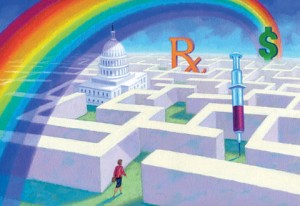 The growth in prescription drug costs covered by employers and Rx plan sponsors are driving them to adopt a long list of utilization management and price-tiering strategies looking to 2012, according to the 2011-2012 Prescription Drug Benefit Cost and Plan Design Report, sponsored by Takeda Pharmaceuticals.
The growth in prescription drug costs covered by employers and Rx plan sponsors are driving them to adopt a long list of utilization management and price-tiering strategies looking to 2012, according to the 2011-2012 Prescription Drug Benefit Cost and Plan Design Report, sponsored by Takeda Pharmaceuticals.
The average drug trend for 2011 — that is, the average annual percentage increase in drug cost spending — was 5.5%, 1.5 percentage points greater than general price inflation of about 4%. The generic fill rate was 73% of prescription drugs purchased at retail. While drug price inflation is expected to increase in 2012, plan sponsors will implement several programs targeting enrollees who are most responsible for high cost and volume Rx consumption; the most popular programs will be disease management (to be used by 62% of plan sponsors), therapeutic substitution (50%), and outbound telephone calls (42%), retrospective drug utilization review (DUR, 40%), and face-to-face pharmacist consults (39%). Disease management and retrospective DUR both fell in use since 2010. Utilization management programs are also commonly integrated into prescription drug plan designs, with the most common tactics being prior authorization, quantity limits, and limits on “refills-too-soon.” Step therapy, too, is growing in use, particularly for medications treating depression, asthma, high cholesterol, and high blood pressure.
The use of tiering drug copays is commonly used as a “nudge” to drive consumers to buy generic substitutes. In 2011, the average mail-service copay was $22.35 for a 30-day supply of generic drugs, $58.51 for preferred brands, and $103.44 for non-preferred brands. In 2010, the range was $19.23 – $53.91 – $97.15. Mail order drugs generally cover medicines that treat chronic conditions, notably diabetes, high blood pressure, and high cholesterol — all of which have generic substitutes available in the market.
At retail, copay amounts are also showing large spreads between generics, preferred and non-preferred brands. The generic copay at retail for a 30-day supply of drugs was $10, $27 for preferred brands, $47 for nonpreferred brands, and $84 for specialty drugs.
The average price of generics at retail has stayed relatively flat since 2000. The average copay for nonpreferred brands rose from about $28 in 2000 to $48 in 2011.
Value-based designs are being incorporated in some drug plans: 43% of plan sponsors are not using VBD tactics at all, dropping from 51% in 2010. The most popular VBD strategies are financial incentives such as reducing copays for specific drug classes (36%), incentives to motivate behavior change (27%), and rewards tied to participation in health risk assessments (21%).
Health Populi’s Hot Points: Employers and health plan sponsors are looking forward to the growing list of prescription drugs going off-patent in 2012 as part of their strategy to manage drug trend. Secondly, managing the specialty drug portion of the Rx bill will be very important to those footing the tab for prescription drugs. Specialty pharmacy networks will be tightening: 48% of plan sponsors are using designated specialty pharmacies, an increase from 40% in 2010. 24% of employers are restricting coverage of specialty drugs on the medical side, doubling from 12% in 2010.
In addition to undertaking new designs for health plans, employers will be spending more resources on educating plan members about their drug plan. As more specialty drugs to treat complex diseases come onto the market, consumers need to understand (1) how the health plan treats these drugs (usually, through a percentage coinsurance multiplied against what can be a sticker-shock retail pharmacy price) and (2) how to be a responsible patient in terms of adhering to therapeutic regimens and using the health plan wisely (e.g., why contributing to an HSA can be an economically beneficial thing to do — as well as spending the money when clinically necessary, and not saving for that rainy day when they feel “really sick”).
Such educational efforts requires more than the usual employee handbook variety of Benefits 101. We’re talking about patient engagement here: and there are many reasons why people opt into filling a prescription, and staying — or abandoning — that script. Patients need to be informed about risks and full information about drugs, their benefits, side effects, and alternatives. Social networks, where patients can converse and share with therapeutic experts — both professional and fellow peer-patients — are available for virtually every therapeutic category and condition. Plan sponsors and, more likely, their benefits consultants should become knowledgeable about these sites where people are already joining together to co-create knowledge and health. Tools and mobile applications, too, can be useful channels in education, adherence support, and condition management. Getting patients more involved in their own care and, more explicitly, in making rational decisions about medication fills, refills, and adherence, would go a long way in improving outcomes and improving plan sponsors’ returns-on-investing in prescription drug spending.




 Thank you, Jared Johnson, for including me on the list of the
Thank you, Jared Johnson, for including me on the list of the  I am so grateful to Tom Lawry for asking me to pen the foreword for his book, Health Care Nation,
I am so grateful to Tom Lawry for asking me to pen the foreword for his book, Health Care Nation,  Thanks to Feedspot for naming this blog, Health Populi, as a
Thanks to Feedspot for naming this blog, Health Populi, as a